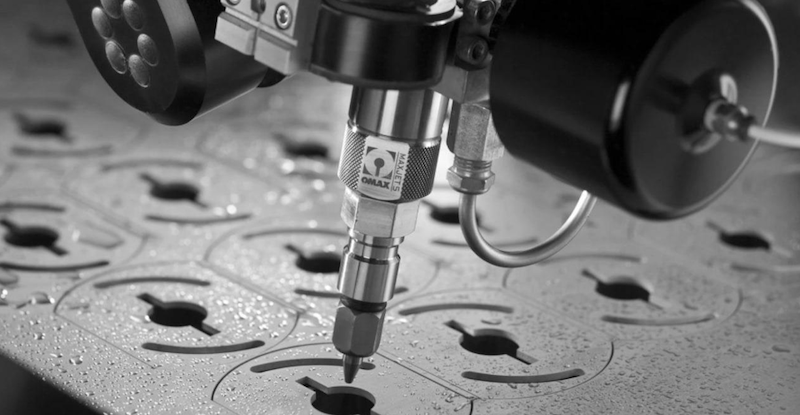Flame Cutting, Plasma Cutting, and Waterjet Cutting – Differences
There are many options for metal cutting when you need it cut to size. Not all processes will work for every job and every type of metal.
You may choose to use flame cutting or plasma cutting for your project. However, it is important that you understand the differences between these cutting methods.
Flame Cutting
The process of flame cutting involves the use of oxygen and fuel to produce a flame that can melt or sever material. It is often called “oxyfuel cutting” because it uses oxygen and fuel to cut the material.
To heat the material to its kindling temperature, flame-cutting uses a neutral flame. Once this temperature is reached, the operator pushes a lever which releases an additional stream of oxygen into the flame. This is used to cut the material and blow out the molten metal (or dross).

The Advantages and Drawbacks of Flame Cutting
Flammable flame cutting is a great option because it doesn’t require power. All you need is a cylinder to hold oxygen and a cylinder to hold fuel gas.
Hoses, a torch, a torch, and a striker will do. It is a great choice for fieldwork. Flame cutting can also be used for cutting extremely thick metals.
The flame cutting process can cut steel up to four feet thick with the right equipment. Flammable cutting is also very affordable.
When it comes to the types of material which can be cut, flame cutting is a disadvantage. Carbon steel and low alloy steels are the only types of materials that can be flame cut.
Cast irons are also not allowed to be flame-cut. The flame cutting process will not cut any other materials. Plasma cutting and waterjet cutting are slower than flame cutting.
The heat of flame cutting can cause metal edges to form a thin, brittle layer from solidified steel. This is called the decarburized coating. This layer may need to be removed depending on the application.
The heat from flame cutting may cause the decarburized area to be affected by heat. This can result in metal in the Heat Affected zone becoming hardened and brittle without any post-cutting heat treatment such as Annealing.
Plasma Cutting
Another thermal cutting process is plasma arc cutting. It uses an electric arc to heat and ionize the gas in order to create plasma.
This is different from flame cutting. An electrode of tungsten is used to create the electrical arc at the plasma cutter torch. Grounding clamps are used to make the workpiece part of the electric circuit.
Once the tungsten electrode has ionized the plasma, it becomes superheated and interacts with the ground workpiece. There are many gases that can be used for producing plasma gas.
The best one will depend on the material being cut. The superheated plasma gas vaporizes the metal and blows out the dross.

Plasma Cutting: Advantages and Disadvantages
Plasma cutting is able to produce high-quality cuts faster than flame cutting. Plasma cutting systems may also have a smaller kerf.
Plasma cutting can be used with most metals that conduct electricity well. Plasma cutting does not have to be limited to steel or cast iron, as flame cutting can also be done.
Plasma cutting can also be used for cutting aluminum and stainless steel. Copper is another option. This process can also be automated.
Plasma cutting can only cut materials that are twice as thick as flame cutting. Plasma cutting is generally not recommended for materials exceeding a few inches in thickness. Plasma cutting is limited to cutting materials that are part of an electrical circuit.
Waterjet Cutting
Waterjet cutting, a mechanical method of cutting material, uses a high-speed, high-pressure stream of water. A high-pressure pump forces water out of the waterjet cutting head.
An abrasive is added to water for materials that are more difficult or harder to cut (for example, metals). This increases cutting capabilities and speeds up travel speeds. The waterjet cutting head collects the excess water and material.
Waterjet Cutting: Advantages and Disadvantages
A water jet cutting machine is capable of cutting many materials. It’s not just limited to metals. Waterjet cutting is safer than flame or plasma cutting because it doesn’t emit harmful fumes.
Waterjet cutting is not a thermal process. The water cools the material during cutting, which means that there is no heat to affect the chemical and mechanical properties of the cut area. You can also combine waterjet cutting with automation.
Waterjet cutting is not suited for thick cuts on hard metals. Thicker or harder metals can reduce cut speed and decrease quality. Waterjet cutting equipment can be expensive and require a lot of maintenance.
What Should I Use for Flame Cutting, Plasma Cutting, or Waterjet Cutting?
There are many factors that you can take into consideration, but here are some guidelines that will help you choose the right cutting process.
Flame cutting: When you have to cut thick steel and cast irons, flame cutting is the best option. Equipment costs must be kept low.
Plasma cutting: When high-quality cuts are required on metals less than 3-4 inches in thickness, plasma cutting should be used.
Waterjet cutting: Waterjet cutting lets you to cut parts precisely without heat. Waterjet cutting can also be used to automate the cutting of nonmetallic materials.

